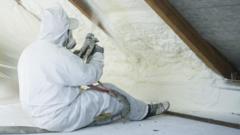
Homeowners across the UK are facing significant challenges with spray foam insulation, as major lenders are increasingly reluctant to provide mortgages for properties with this type of roof insulation. Research suggests that approximately 250,000 homes have spray foam insulation, much of which was installed under the government’s Green Homes Grant scheme.
Spray foam insulation comes in two forms: closed cell and open cell. Closed cell foam is rigid and was previously used to stabilize roofs, while open cell foam remains soft and is primarily used for insulation. However, both types can potentially cause problems if improperly installed, such as trapping moisture and risking timber decay.
The BBC’s investigation revealed that a quarter of the UK’s largest mortgage providers will not lend against homes with spray foam in the roof. Five major lenders, including TSB Bank and Skipton Building Society, explicitly stated they would not provide mortgages for such properties. Other lenders, like Lloyds and Nationwide, are taking a case-by-case approach, often requiring additional documentation or specialist reports.
Homeowners like Wendy Rowe and Gary Wright have experienced significant difficulties. Rowe’s family struggled to sell her late father’s home and ultimately paid thousands to have the insulation removed. Wright discovered spray foam in his property when attempting to remortgage, leading to complications and higher rates.
The Insulation Manufacturers Association argues that spray foam can be beneficial if correctly installed. Simon Storer, the organization’s chief executive, suggests that fear among lenders is based on a lack of knowledge and outdated industry guidance.
The Homeowners Alliance (HOA) currently does not recommend installing spray foam due to ongoing issues with lenders and unregulated traders. They advise homeowners with existing spray foam to:
1. Collect all relevant documentation
2. Contact the original installer for a potential “health check”
3. Consider an independent assessment by a qualified surveyor
The government has stated that any insulation measures fitted under their schemes must be installed by Trustmark-registered installers to the highest standards, with any issues promptly addressed.
Experts like Stephen Hodgson, former boss of the Property Care Association, highlight that poor installation can lead to significant problems. The nature of spray foam can make it difficult for valuers to inspect roof timbers, further complicating mortgage applications.
In 2023, the Property Care Association published an inspection protocol to help surveyors and lenders assess potential risks in pitched roofs with spray foam insulation.
Homeowners with spray foam insulation are advised to be proactive, gathering documentation, seeking professional assessments, and understanding the potential implications for future property sales or remortgaging.








